The range of products available for hiking and camping is today pretty overwhelming, with specialized high tech gear and gadgets that can often cost a fortune or two. However, much of it is quite unnecessary, and only a few items are strictly needed, while a few more will help make you much more comfortable, letting you have a greater and more interesting experience. I will here try to give a few pointers on what to invest in and what to think of when doing so.
The list is divided into five parts:
- Clothing
- Carrying
- Shelter
- Camp gear
- Personal equipment
So without further ado, here goes.
1. Clothing
Your clothing is at the top of the list of things you should consider carefully before buying, since it is what you will be using and depending on the most. For that reason it is one of the things I would actually invest more in as it is so important, and with good quality you get long lifetime for the garments, meaning it won’t necessarily cost more in the long run. Pretty much all other gear can be bought at bargain prices.
However, if your budget is tight, then looking at military surplus is a great alternative, both for clothing and backpacks. They are always very durable and commonly, but not always, well-designed, often sold cheaply since the military look limits the customer base. The SAS Paratrooper smock or the regular British Army smocks are good options here, just as an example.
Also, we all have different needs depending on what we intend to do and under what circumstances we do so, so your specific needs might not be quite the same as mine.
Simple leather boots
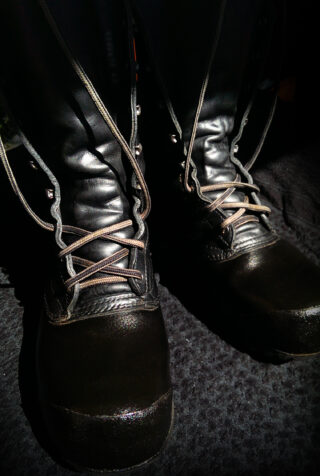 Make sure to buy renowned quality boots that will last you a long time. Single layer leather boots can be used any season if you add insoles and wear appropriate socks. Buy a size larger than regular boots so you can adjust the size with different thickness of insoles and socks. With two pairs of socks you run a far lesser risk of blisters even when new, and wearing thick socks even in summer time is more comfortable than you might think.
Make sure to buy renowned quality boots that will last you a long time. Single layer leather boots can be used any season if you add insoles and wear appropriate socks. Buy a size larger than regular boots so you can adjust the size with different thickness of insoles and socks. With two pairs of socks you run a far lesser risk of blisters even when new, and wearing thick socks even in summer time is more comfortable than you might think.
Tall boots protect your lower legs to a degree and also offer better stability so you run a lesser risk of spraining your ankles.
Quick lacing with hooks on the shaft is far more practical than lacing with holes.
Make sure that the tongue is sewn onto the shaft all the way up so you can walk in fairly deep water.
Some boots have the lower half made out of rubber and are perfect for almost any condition.
Full leather boots can be made to fit your feet better by soaking them in water and letting them dry on your foot as you walk around in them.
Make sure to maintain them with grease for the leather and if needed vaseline or glycerine for synthetic rubber details. That way they will also stand up to water and wear better.
Rugged pants & jacket of non-synthetic material
Long, loose pants are preferable to shorts when you move around in the bush, as your legs are then protected from scratching and small cuts as you move about. They are also protected from parasites like mosquitos, horse flies and ticks.
Rugged material is better, since then you can sit or lie down without worrying about your gear. Also pants that are reinforced over the knees and butt of course hold up better to field wear.
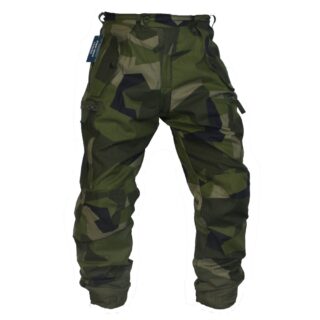 Make sure both pants and jacket are loose enough to allow you to add more layers of clothing underneath without restricting your movements in any way.
Make sure both pants and jacket are loose enough to allow you to add more layers of clothing underneath without restricting your movements in any way.
Many synthetical materials are prone to melting or burning quickly when exposed to flying embers or fire. For that reason natural material like wool can be better. It is the material used in the clothing of firemen after all, and is also used in high safety environments like trains and aircraft. Wool also keeps you warm better even when wet. Military gear is often manufactured out of wool, especially older clothing.
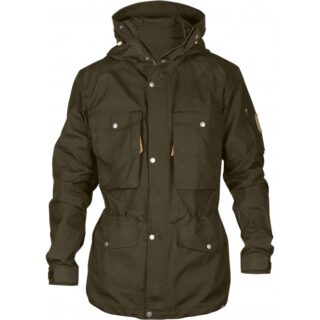 Easily accessible and decent-sized pockets are good. Keep a first aid kit in your right thigh pocket at all times. Some jackets have pockets placed specifically to work well with carrying a backpack.
Easily accessible and decent-sized pockets are good. Keep a first aid kit in your right thigh pocket at all times. Some jackets have pockets placed specifically to work well with carrying a backpack.
Make sure that the pockets can be closed properly and make a habit of doing so. Always.
A hood on the jacket is great both for protection against rain, snow and sun. Some have a piece of steel wire sewn into the front so you can change the shape of the hood.
Velcro wears out with time, so buttons are better.
Zippers should be covered so there is no leakage of body heat or possibility for wind to pass through the zipper.
Underwear and insulation for all seasons
Using the layer principle you can wear the outer garments for all seasons, just adding inner layers, and scarves, caps and gloves as needed. There is no rocket science to it. Just add what is needed so you feel comfortable. And make sure to dress according to the layer principle so warm air inbetween the garments and inside the middle layer keeps you warm. This also makes it possible to adjust according to changing weather conditions or work load.
Working gloves
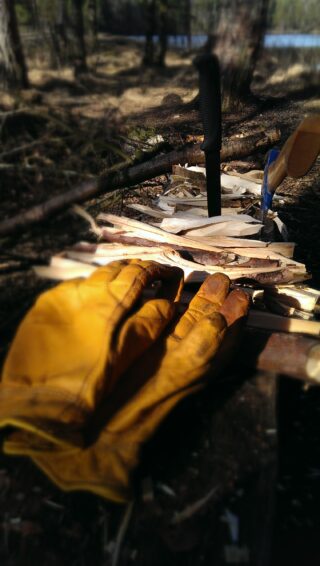 Working gloves is something easily missed when going into the bush. However, it makes working with brush and wood much more comfortable and easy as you can work without concern for hurting yourself on needles and splinters. Simple leather gloves are perfect for this use and are quite cheap to buy.
Working gloves is something easily missed when going into the bush. However, it makes working with brush and wood much more comfortable and easy as you can work without concern for hurting yourself on needles and splinters. Simple leather gloves are perfect for this use and are quite cheap to buy.
Leather belt
There are a few reasons to choose a leather belt before a synthetic one, with the primary reason being that you can strop your knife using it. It makes a significant difference to the edge of the blade if you strop it after sharpening.
They also tend to be simple in construction and thus meaning lesser risk of failure. Simply put, they are generally more reliable.
A scarf
A square thin scarf like a shemagh is probably the single most versatile clothing accessory you can get. Fold it to a triangle or rectangle and wear it as a scarf around your neck, or covering your shoulders for warmth. Or wear it as a cap to protect the scalp from sun or cold, or bedouin style to protect the face too. Or in emergency use it as a mitella to let your injured arm rest, or as pressure bandage on open wounds. It really is very handy due to the many options it offers.
2. Carrying
Two backpacks
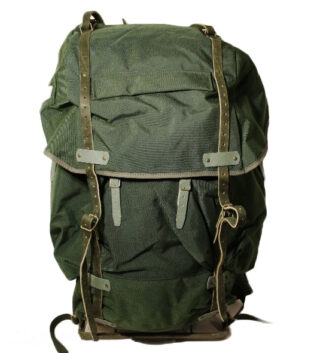 The backpack is naturally one of your most important pieces of gear as it can ruin your experience if it doesn’t suit your needs. The two most important aspects are
The backpack is naturally one of your most important pieces of gear as it can ruin your experience if it doesn’t suit your needs. The two most important aspects are
- Does it fit you well?
- Can it carry what you need to bring?
If you have the money, you can ask for professional help in a store. If not, then try buying cheap but still good second-hand gear, perhaps military surplus and test things out until you find something you are satisfied with. My personal favourite is the Swedish Military LK-70, a 70 litre external frame pack that is perfect for somewhat longer hikes and also can carry an axe or skis inside of the side pockets. And since the pack can be removed from the frame, you can also use it to carry firewood, game or whatever heavy objects you need to carry around in the woods.
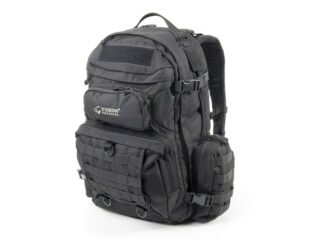 For shorter hikes, it is good to have a smaller pack. There is no point in carrying a big half-empty pack with you. Here there are numerous options available at moderate prices. Since you aren’t carrying as heavy a load, it is not as important that it fits you perfectly.
For shorter hikes, it is good to have a smaller pack. There is no point in carrying a big half-empty pack with you. Here there are numerous options available at moderate prices. Since you aren’t carrying as heavy a load, it is not as important that it fits you perfectly.
Again synthetic materials have some advantages in terms of weight and water resistance, but they are also prone to melting when exposed to fire so keep it away from flame and flying embers.
Ditty bags
A ditty bag is a smaller regular bag that carries small items that you commonly use and therefore need easy access too. In many cases pockets on jackets and pants already serve this function but it can still be practical especially when trekking. And it is also more comfortable sitting or lying down without a ton of gear in your pockets.
Another use for it is to carry specific gear, like fishing gear, which you don’t want to mix up with everything else.
A dry-bag
Some items absolutely have to be kept dry as you travel to your camp site. Stuffing your sleeping bag into a dry-bag is a good idea, especially if you know that there is a risk of rain. I store my tarp, my hammock and my underquilt in a dry-bag too. Budget-wise they don’t cost much and are well worth the investment. I even use it in camp as a quick access “shelf” hanging from a tree or a line, to have easy access to small items and tools.
A toiletry bag
Keeping things organized is important for many reasons, not least being able to find things easily and quickly, and also to keep track of things so you don’t lose them.
Most likely you already have one of these in your home, but a small one with the absolute necessities for good field hygiene should be brought along. As always packing space is a factor to consider.
Plastic bags
These of course are readily available and you already have many in your home. They are great for collecting your garbage & dirty laundry, but also for collecting tinder, smaller firewood and other small things. Make sure to select a more sturdy one with thicker and more durable plastic.
3. Shelter
A tarp & rope
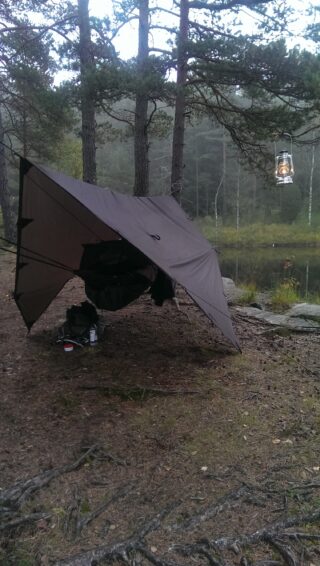 Rope can be put to so many different uses; to build shelter, slung over a branch to lift up your water container to comfortable height, and to lift your food out of the reach of preying wildlife.
Rope can be put to so many different uses; to build shelter, slung over a branch to lift up your water container to comfortable height, and to lift your food out of the reach of preying wildlife.
Combined with a tarp you also have quick and simple cover for yourself and your gear. A tent isn’t strictly needed, provided you have a tarp, good clothing and a sleeping bag suitable for the season.
Tarps come in many different brands, shapes, sizes and quality. Most work well to protect from both wind and rain. Make sure to get a large enough tarp so you can arrange it in different shapes to protect you well. There are plenty of videos on YouTube that show ways of setting up tarps.
Tents & hammocks
Additionally you can also get tents or a sleeping hammock. Both come in different designs and sizes for different budgets and needs. For many a simple and inexpensive tent is enough, especially when camping in the woods. For Scandinavian mountain camping the requirements are a bit different due to strong winds, not seldom nearing storm conditions, and because of exposure to snow and hard rain. Consequently more durable tents are a good investment for such trips, but for the odd trip to the woods, there is really little need to invest in the more expensive variants.
A sleeping hammock is a great type of sleeping arrangement, since you sleep quite comfortably and more or less flat. Most require a tarp for cover though. And the bottom can get a bit cold as there is nothing to keep you properly warm when the sleeping bag is compressed thin (See below). Also, for some it can feel a bit discomforting as you sleep alone, seemingly more exposed without the comfort of others sleeping right next to you.
A sleeping bag & sleeping mat
Sleeping bags are split into two categories, down or synthetic. Down is generally lighter, but takes longer to dry when wet. Both work well with different temperatures and can be further separated into different seasons. Some, like some bags by Carinthia are part of a system where pieces can be used separately or together to suit different conditions. A bivy bag can be used as a mini-tent to protect your sleeping bag from rain.
Special considerations should be made if you plan to sleep in a hammock. A centre zipper makes it easier to get in and out, and a broader foot end is better for comfort. Also, since you are pressing down against the hammock, an underquilt underneath the hammock will keep you much warmer as you can get quite cold otherwise.
All modern sleeping bags have synthetic outer shells and as already mentioned that is problematic when near fire, and sleeping close to fire can thus be hazardous. A solution is to sew together a simple wool blanket and put your sleeping bag inside of it. That way you run a far lesser risk of damaging your sleeping bag from flying embers.
A sleeping mat is more or less invaluable to be able to sleep on uneven ground without preparing it with grass, furn, leaves and twigs. Self-inflatable mats are naturally more comfortable, but often add quite a bit to the overall weight of things to carry.
4. Camp gear
Field kitchen with kitchenware
There are numerous alternatives for field kitchens. Basically they can be divided into
- Wood, solid fuel burners
- Alcohol, diesel, gasoline, kerosene burners
- Gas burners
- Mixed fuel burners (that can be used with the latter two fuel types)
All these have different advantages and disadvantages for different environments and climates.
Wood, solid fuel burners
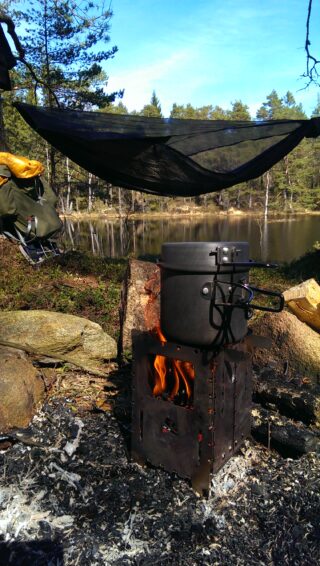 These are very simple and still quite effective. Solid fuel burners use fuel like Esbit tablets which require little space and are lit easily in different conditions.
These are very simple and still quite effective. Solid fuel burners use fuel like Esbit tablets which require little space and are lit easily in different conditions.
Wood burners require you to collect a couple of handfuls of twigs & pine cones for fuel, but can also be used with pellets, solid fuel or even have a small alcohol burner placed inside of them. They work very well provided you have dry wood or solid fuel tablets to use.
Of course a regular improvised fireplace from some rocks or logs also works, but are not quite as economical as wood burners, even if very economic use is also possible, like e.g. among the nomadic Sami of the far north.
Alcohol, diesel, gasoline, kerosene burners
This is the old traditional type of burner where you use liquid fuel for cooking. Works reasonably well even in winter, but is commonly, in my experience, less effective than both wood and gas burners. In really cold weather a preheater attachment can be used to make it work better.
Gas burners
These are very effective and boil water quickly, about twice as fast as liquid fuel burners, but have a tendency to be difficult in colder climates, especially below -10 degrees Celsius. They are also a more expensive solution. Different mixes of gas are recommended for different temperatures, with some working better in winter time. However, for more extreme conditions you will need to look at the next option.
Mixed fuel burners
Mixed fuel burners can use both alcohol, gasoline, diesel, kerosene and gas for fuel. In that respect they are very versatile. They are very effective and clean, requiring little fuel. They are unfortunately also the most expensive solution and therefore mostly used by professionals or in situations where supply of a single type of fuel can be problematic, or where different climates and environments can be expected, like when travelling abroad for trekking or climbing. In such circumstances, fuel conservation is also an important consideration.
***
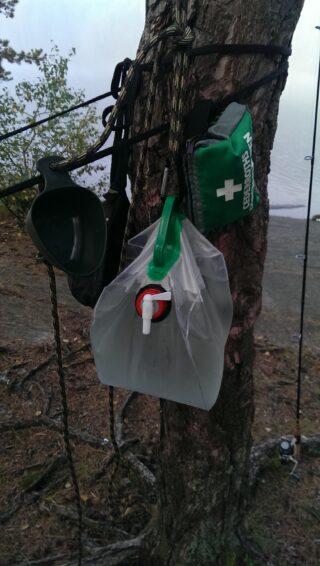 As for the kitchenware there isn’t much to say about it. Just make sure it is durable and easy to wash.
As for the kitchenware there isn’t much to say about it. Just make sure it is durable and easy to wash.
Pots and pans of various sizes should ideally fit into each other so they take up little space in your backpack. Sometimes you can even store your burner inside of these. Try to avoid plastic details, so you can use your pots over open fire with little risk of melting the plastics.
A deep plate is more versatile than a regular, as are a bowl or a guksi, since you can eat more types of food in them, including porridge and soup.
A foldable water container is very practical since it takes up little space in your pack, but can contain a lot of filtered drinking water.
Fire steel and gasoline lighter
A refillable gasoline lighter is a proven reliable source of fire and carrying a cannister of extra fuel with you safeguards that you won’t suddenly stand with an empty lighter. Some prefer super-effective storm proof gas lighters, but I have never liked them or felt a need for them.
Swedish Army Fire Steel is simple to use once you get the hang of using proper tinder and works both in windy and wet conditions. Make sure to train a bit in advance though so you don’t have to rely on it the very first time you use it. It is not difficult, but requires some technique.
A lantern
 This is the central light in your camp that helps you in case you need to get up at night for whatever reason. I prefer a kerosene lantern since I then know exactly how much fuel that remains, but battery lanterns or solar driven ones take up far less space and weigh less since you don’t need to carry fuel for them. There is a distinct “coziness” factor with flickering flame though.
This is the central light in your camp that helps you in case you need to get up at night for whatever reason. I prefer a kerosene lantern since I then know exactly how much fuel that remains, but battery lanterns or solar driven ones take up far less space and weigh less since you don’t need to carry fuel for them. There is a distinct “coziness” factor with flickering flame though.
A pair of reliable and sharp knives suited to your needs
 A good knife is the most important piece of gear you carry with you. With it you can prepare food, fire material, shelter, eating tools and more.
A good knife is the most important piece of gear you carry with you. With it you can prepare food, fire material, shelter, eating tools and more.
There are as many opinions on what makes a knife good as there are people. So try several out and see what suits you and your own needs. Personally I like to carry two different knives for different purposes, and also for safety in case I should lose one of them.
For smaller tasks I tend to prefer.
- Very sharp
- Easy maintenance, meaning stainless steel
- Easy to sharpen, meaning scandi grind and not super-duper hard steel
- Comfortable grip so I can use it for extended periods of time
- Not too thick so I can carve comfortably. Up to 3mm is good
- Not too broad blade since too much makes carving difficult. 30mm is about the limit
- No finger guard over the back spine, so I can put my thumb against the spine when carving
- A full length spine that isn’t sharpened, so I can put my other thumb on the spine when carving
- No saw teeth or serrations on the blade as that only makes carving more difficult
- Edge that is sharp almost all the way to the grip thus making it good for carving
- A full tang that has the back end exposed so I can use it for light hammering
For larger tasks where the knife can replace an axe, I prefer.
- Good sharpness
- Easy maintenance, meaning stainless steel
- A thicker blade that can stand up to batoning logs. 3.5-5mm is a good range
- A full length spine that isn’t sharpened, so I can baton it without the “club” coming apart from striking a thin edge
- No saw teeth or serrations on the blade as that only makes cutting more difficult.
- A full tang that has the back end exposed so I can use it for light hammering
Some people like to use the spine of their knives to make fire with a fire rod, but I have never liked that and keep the two separate. I consider it a bit of a survivalist hype that will be short-lived around my neck of the woods. However, if that is something you want to do, then you need a blade of carbon steel, not stainless. The spine also needs to be square, which is another reason why I don’t like this habit. It makes thumbing the spine very uncomfortable and consequently far less usable for carving.
Some of my favourites of the great number of knives I have tested over the years, are the Mora knives, Peltonnen’s/Fiskars’ Sissipuukko (Ranger Knife), ESEE-5, EKA Swede 10, Fällkniven A1, S1 and F1 and Frosts Laplander. They all tick off many of the above. Of course I am culturally biased to like Scandinavian knife design having grown up in Sweden and being used to northern climates and conditions, but their particulars in design come from centuries of experience of use in the climate and conditions we have here. They just work very well for the majority of tasks you need them for.
An axe that fits your needs
Using a big knife for batoning wood is not a common use in Scandinavia and it has only arrived with the boom of bushcrafting over the last decade. Before that, a good axe was the standard tool for splinting logs in the woods, and for most Scandinavians it still is.
Almost all traditional axes are of quite good quality and you can get used axes dirt cheap, even from military surplus. Just make sure the shaft is without cracks or bigger flaws and that the axehead is secured tightly. Removing rust and sanding the shaft is simple to do and can be quite fun, as you restore a worn-down axe to new life.
Make sure to get an axe of a size and design that suits your personal needs. Axeheads come in numerous designs and the length and shape of the shaft decides how comfortably you can use the axe for different purposes. Also, remember that you need to be able to carry it with you on your pack so very large axes can be problematic. Likewise, a very small axe will only work for smaller tasks and a bigger knife can easily replace it then, while also being more versatile.
Make sure to learn how to use it well as far too many accidents where people end up chopping their axe straight into their shin have happened. In the woods that can get quite serious.
A small folding saw
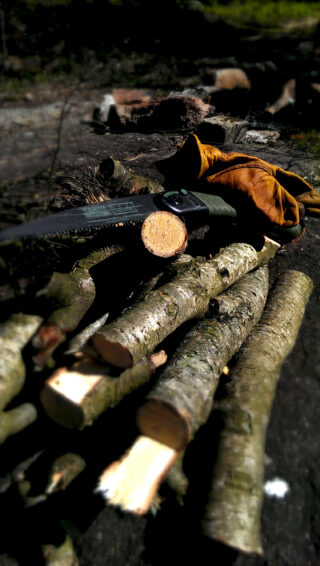 A folding saw is the easiest and quickest way to cut off even quite thick branches. A knife and axe will take longer and also cost more energy. A very popular folding saw is the Bahco Laplander and I always bring one myself. It makes collecting and preparing firewood much easier.
A folding saw is the easiest and quickest way to cut off even quite thick branches. A knife and axe will take longer and also cost more energy. A very popular folding saw is the Bahco Laplander and I always bring one myself. It makes collecting and preparing firewood much easier.
The blades can be replaced but can be a bit hard to find. I have only seen them in online stores in England and Denmark.
A sharpening stone
A sharpening stone isn’t something you necessarily need to bring along, but it is an important part of your equipment. I have tried several solutions and my current favorite is the Spyderco Triangle Sharpmaker. It is a simple system with a stand with holes at preset angles into which you insert rods of different grades, as always, moving from rougher grades to finer. I have also used the rods standalone to reshape blades with good experiences from it.
Sharpening and reshaping blades is a good skill to have and it doesn’t require that much practice to get a decent edge. Scandi grind is one of the simplest bevels to work with and it is worth keeping in mind when you choose the knife you will be sharpening.
Hand sewing awl
 Sooner or later your equipment will break and being able to make quick and simple field repairs is invaluable. Duct tape might fix many things, but actually being able to sew your boots, backpack, clothing or tent properly together again on site is great.
Sooner or later your equipment will break and being able to make quick and simple field repairs is invaluable. Duct tape might fix many things, but actually being able to sew your boots, backpack, clothing or tent properly together again on site is great.
For that purpose a small hand sewing awl like the Speedy Stitcher is a great tool and it is dead easy to use. And as a bonus you get a tool which you can use to make your own knife sheaths too.
A water filter
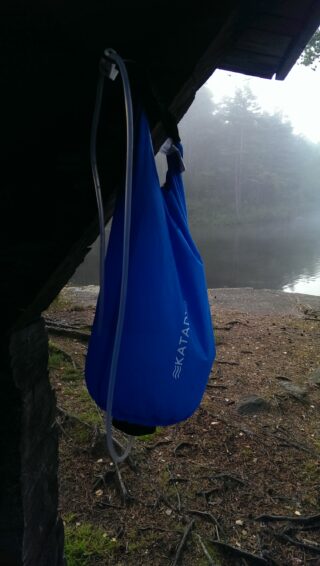 The importance of good access to water cannot be overstated. We should be drinking about 1-1.5 litre of water per hour when physically active and 2 litres per day when physically inactive. For winter time we should drink even more, which might surprise many, as we just don’t notice dehydration the same way. A sign of dehydration is of course darker urine and feeling thirsty. Drinking too little, like eating too little can quickly affect your thinking, clouding your judgement and causing you to make unnecessarily dangerous or otherwise bad decisions.
The importance of good access to water cannot be overstated. We should be drinking about 1-1.5 litre of water per hour when physically active and 2 litres per day when physically inactive. For winter time we should drink even more, which might surprise many, as we just don’t notice dehydration the same way. A sign of dehydration is of course darker urine and feeling thirsty. Drinking too little, like eating too little can quickly affect your thinking, clouding your judgement and causing you to make unnecessarily dangerous or otherwise bad decisions.
So, with all that in mind, there are only two ways of getting water; either bringing it with you, or collecting it in the area where you are. The former is extremely exhausting as anyone who has tried it knows. Carrying a few litres is fine, but carrying enough to sustain you and friends or family for several days just isn’t doable for any longer distances.
In parts of Scandinavia most water in lakes and streams is drinkable straight from the source. However, there is always a risk of bacteria, protozoans and viruses, especially near farmland. For that reason a water filter is a good thing to bring along. They are quick and effective in removing the most common threats and gives you a bucket of clean and well-tasting water in a matter of minutes. It should be noted though that they are not a 100% guarantee either and they do not protect against viruses.
A well-equiped first aid kit
 This should always be brought with you. Keep in mind though that the contents and amount of items should be dependant on how many you are. It is very different trying to handle first aid kits on your own, especially with the most common wound; finger cuts, than giving help to others.
This should always be brought with you. Keep in mind though that the contents and amount of items should be dependant on how many you are. It is very different trying to handle first aid kits on your own, especially with the most common wound; finger cuts, than giving help to others.
The larger the group and the longer the time, the higher the risk that someone will be in need of some treatment gets, be it a sprained ankle, a cut, fever, stomach problems or simply a headache.
Prepepared kits are readily available but you might want to adjust the contents somewhat depending on how you will be using it. Again, keep a small first aid kit on your person in your right thigh pocket so it is easy to get out, even if you have cut yourself, which usually happens on the left hand. The reverse is of course true for lefties…
For larger groups bigger prepepared packs are also available for purchase, with some even defined for specific contexts like mountaineering or trekking.
5. Personal equipment
A whistle & colourful fabric
If you get completely lost, and if you, as you should have, have told people that you are going off into nature and exactly what area you will be in and for how long, then people will miss you and call for aid to find you. Making it easier for them to find you is of course a good idea. Two things that can help you in this is a whistle and colourful fabric. While natural colours are tempting for clothing and tarps etc, something brighter can be a great help in emergencies. Also, shouting to draw attention to yourself is not as effective as, and far more energy draining than blowing in a whistle. There are whistles specifically designed for this purpose readily available in many stores.
A pair of binoculars
Binoculars are good for two things. First of all it makes your experience greater and more interesting as you can study wildlife and nature closer. Second it can also be an important tool in case you get lost. There is no need to spend a fortune though. Simple binoculars can work perfectly fine and used or refurbished binoculars are good alternatives if you are on a budget. Smaller binoculars are easier to carry at all times, while larger lenses work far better in poor lighting conditions.
A pair of good flashlights
Being able to see what you do in the dark can potentially be a life-saver in case you happen to injure yourself or get lost. Like with knives it is good to bring a spare in case your primary flashlight stops working. Modern flashlights are super-effective but older and very durable Mag-Lites also work very well and can be had for a few bucks only. They are well worth the investment.
A compass
Compasses come in many different varieties, with some more advanced variants where you “aim” for specific points in the landscape using targeting lids and/or mirrors, thus making it possible to navigate with higher degree of accuracy, but even a simple compass will work well enough.
As good as it is being able to read the signs in nature for compass directions, they are always more general and imprecise, so a proper compass will always show you the directions better. It helps you find your way, makes it possible to move reasonably safely outside of paths and trails and just makes things more fun and interesting, giving you access to things you wouldn’t see otherwise. Make sure to have a good and detailed map of the area you plan to visit and learn how to use the two well.
Fishing gear
This is of course not a necessity, but a great relaxing activity and the food is as fresh as it can get. Doesn’t have to be anything fancy. A small spin casting rod, a floater/bobber, sinkers, a few hooks, and bait is quite enough. Of course knowing a thing or two about fishes and their habits helps make it even more fun.
***
Getting all this gear might seem daunting and sure, it will still cost a fair bit. However, add pieces bit-by-bit and over time it won’t be so difficult, and remember that there are always good budget alternatives available through military surplus. All of these will make your outdoors life, not easy perhaps, but with less hassle and struggle, so you can do your tasks well and focus on the greater experience.
I hope you found this useful! Thanks for reading!

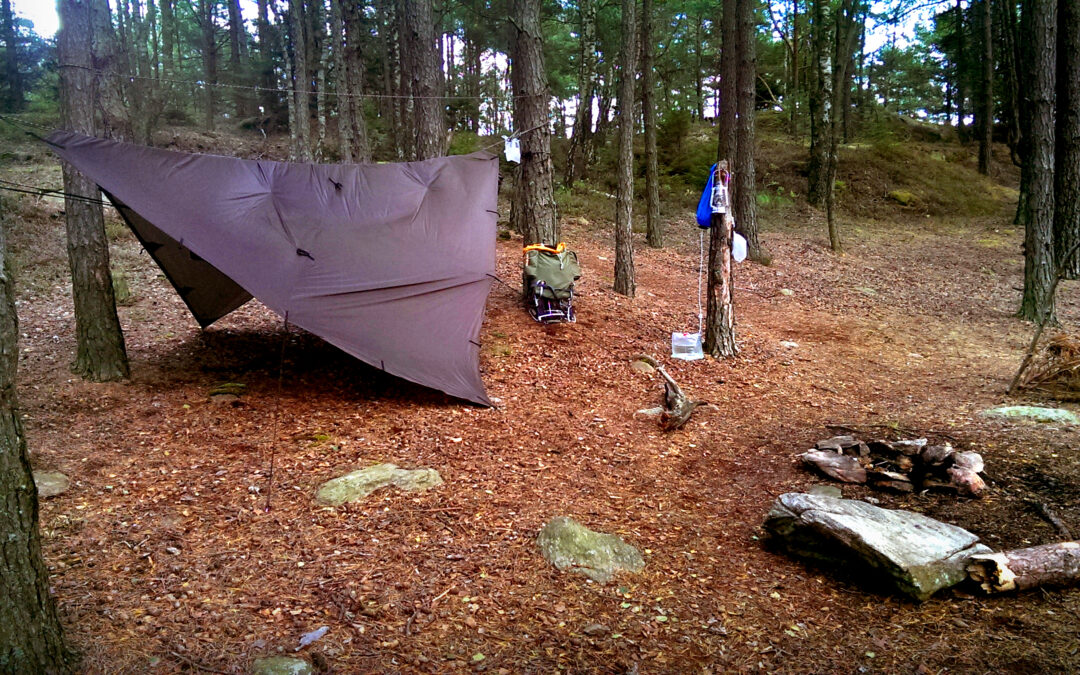



Great stuff and a very thorough list of kit. Strange to see another person using the Sissipukko (not too common a knife in my experience).
Awesome article and list. What’s the pants name or brand? They look awesome
The pants are repro versions of the Swedish Military combat pants of m90 model. The originals can sometimes be found as surplus, e.g. at varusteleka.fi, but are also manufactured by both Active Life Equipment and Army Gross. You can even get them in black, blue or olive drab. I wear black ones every day.
http://www.activelifeequipment.se/klader/faltbyxa-m90-17
http://armygross.se/militarklader/m90-klader/a-nordic-army-m90-faltbyxa-m90-camo/